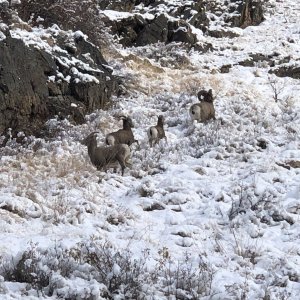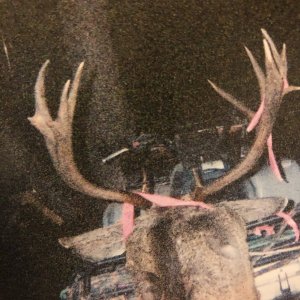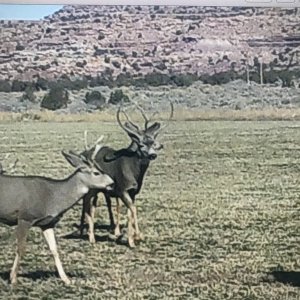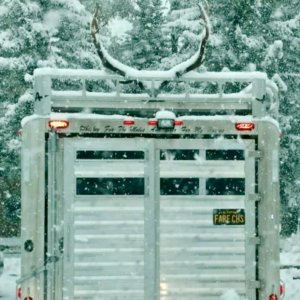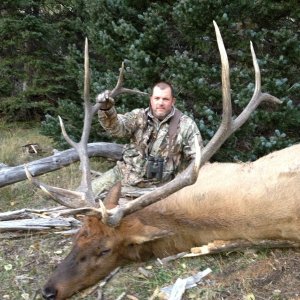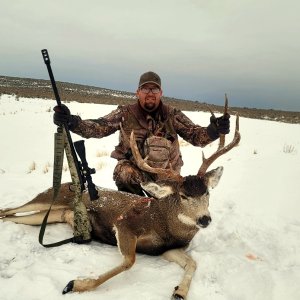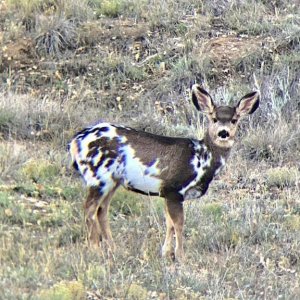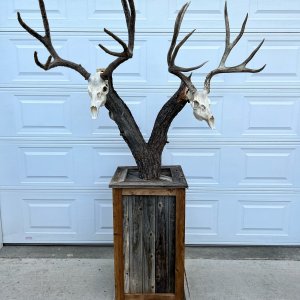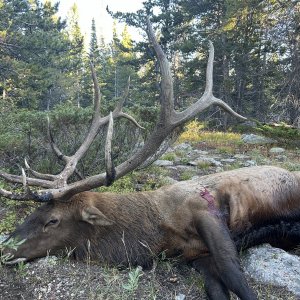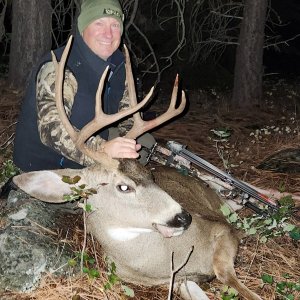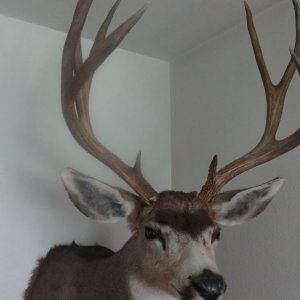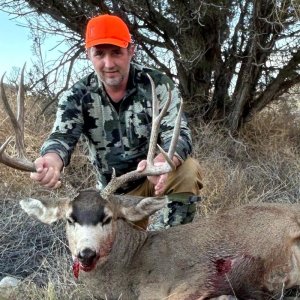When scouting for mule deer, how much time do you spend in any one area. In the morning do you sit one basin in hopes to see one come out. or do you hit as many as possible before they make their way back to the trees. If your morning scout is a bust do you look for other areas in the evening or stay in the same area to see if you missed anything in the morning. how often do you find that new bucks will show up in an area, versus covering country looking for more. I have been out on one scouting trip so far and i got the feeling the deer are scattered and did not see many bucks. With feed and water everywhere, will the bucks stay lower and in the thick stuff versus feeding into the high country? My other thought is the "green wave" has been slower to move up the mountains this year and because of this the deer dont have to go to the high country for late summer green feed. Counting down the days till i go out again!
You are using an out of date browser. It may not display this or other websites correctly.
You should upgrade or use an alternative browser.
You should upgrade or use an alternative browser.
Scouting
- Thread starter HUNTFISH
- Start date
prairie_ghost
Member
- Messages
- 32
Is this a new unit, so you're just trying to get a feel for areas that should have critters during your upcoming hunt?
Or are you specifically looking for a bachelor herd/special individual deer that would be the focus of your efforts come season?
I think a little clarity here might help those willing to share advice.
Or are you specifically looking for a bachelor herd/special individual deer that would be the focus of your efforts come season?
I think a little clarity here might help those willing to share advice.
LAST EDITED ON Jul-21-19 AT 02:16PM (MST)[p]LAST EDITED ON Jul-21-19 AT 02:10?PM (MST)
It is an area i am very familiar with. So I find myself wondering whats in the next spot. Just curious how others approach their scouting. I typically cover lots country looking for a mature buck.
It is an area i am very familiar with. So I find myself wondering whats in the next spot. Just curious how others approach their scouting. I typically cover lots country looking for a mature buck.
LAST EDITED ON Jul-21-19 AT 03:23PM (MST)[p]As hot as it is, the deer are quick to find their beds. From 5:30-7am
Evening movement and feeding was from 7-9:30pm
This was my experience last weekend.
My camp was set up where they moved through around midnight-2am on their way to the water. Cuz I heard them come through my camp.
The deer were up high like normal and bucks were bachelored up. (Saw 8 bucks together) the bigger bucks were quicker to find their beds ahead of the group.
I caught them between their night time drink headed to their morning beds.
All Bedded on north facing slopes in the shade about a quarter mile away from the pond they drink from.
Yes water is prevalent and feed is everywhere.
But I typically give it one evening and one morning in a particular basin to scout before moving. I still won't see all the deer. Maybe most but not all.
My advice is be patient and give an area at least the last couple hours of the day and the first couple hours of light.
Find a good vantage point and sit.
I use binos on a tripod to typically find them and a spotter to switch out when I want to get a close look.
Their ?habits? were typically the same as years past except their feeding areas have moved closer to the north facing slopes.
Focus on looking in areas that will stay shaded for a better part of the day.
They hate the hot sun just as much as us. Keep that in mind.
Good luck
"Wildlife and its habitat cannot speak. So
we must and we will."
Theadore Roosevelt
Evening movement and feeding was from 7-9:30pm
This was my experience last weekend.
My camp was set up where they moved through around midnight-2am on their way to the water. Cuz I heard them come through my camp.
The deer were up high like normal and bucks were bachelored up. (Saw 8 bucks together) the bigger bucks were quicker to find their beds ahead of the group.
I caught them between their night time drink headed to their morning beds.
All Bedded on north facing slopes in the shade about a quarter mile away from the pond they drink from.
Yes water is prevalent and feed is everywhere.
But I typically give it one evening and one morning in a particular basin to scout before moving. I still won't see all the deer. Maybe most but not all.
My advice is be patient and give an area at least the last couple hours of the day and the first couple hours of light.
Find a good vantage point and sit.
I use binos on a tripod to typically find them and a spotter to switch out when I want to get a close look.
Their ?habits? were typically the same as years past except their feeding areas have moved closer to the north facing slopes.
Focus on looking in areas that will stay shaded for a better part of the day.
They hate the hot sun just as much as us. Keep that in mind.
Good luck
"Wildlife and its habitat cannot speak. So
we must and we will."
Theadore Roosevelt
If it's an unknown area to me, my time spent observing a basin wouldn't change.
My viewing angle probably might.
(I spend the time at a vantage point in the morning and move to a different vantage point overlooking the same basin in the evening)
I'm always taking note of where there is water when I see it or find it.
However it's not my focus. There tendencies and habits are. That's where you find the parts to the puzzle.
My focus is locating them in the morning and evenings and trying to put pieces of a puzzle together.
If I locate them in the morning, I will always try and find out where they bed. Then ask myself why they chose that spot. Is it to get out of the wind, is it the heat they are avoiding??
It helps change your mindset to think like them.
But regardless.....
It takes quite a bit of time in a specific area to notice the patterns.
If it's new, you gotta spend the time to put the pieces of the puzzle together.
Some basins are full of animals when the basin next is practically always empty. Is it the feed? The cover? Pressure? Predators?
When you get in a hurry to see too much country too fast, you'll probably miss what's hanging around.
I see deer bed 100 yards from water that they never touch. But will travel a half mile to a different water source at night.
But it takes time in an area to learn their habits during the summer months.
If it's multiple basins to check, I need multiple days to scout
"Wildlife and its habitat cannot speak. So
we must and we will."
Theadore Roosevelt
My viewing angle probably might.
(I spend the time at a vantage point in the morning and move to a different vantage point overlooking the same basin in the evening)
I'm always taking note of where there is water when I see it or find it.
However it's not my focus. There tendencies and habits are. That's where you find the parts to the puzzle.
My focus is locating them in the morning and evenings and trying to put pieces of a puzzle together.
If I locate them in the morning, I will always try and find out where they bed. Then ask myself why they chose that spot. Is it to get out of the wind, is it the heat they are avoiding??
It helps change your mindset to think like them.
But regardless.....
It takes quite a bit of time in a specific area to notice the patterns.
If it's new, you gotta spend the time to put the pieces of the puzzle together.
Some basins are full of animals when the basin next is practically always empty. Is it the feed? The cover? Pressure? Predators?
When you get in a hurry to see too much country too fast, you'll probably miss what's hanging around.
I see deer bed 100 yards from water that they never touch. But will travel a half mile to a different water source at night.
But it takes time in an area to learn their habits during the summer months.
If it's multiple basins to check, I need multiple days to scout
"Wildlife and its habitat cannot speak. So
we must and we will."
Theadore Roosevelt
mickeyelk
Very Active Member
- Messages
- 1,895
Sounds good. I'll have to keep in mind what you said. I'm hunting a new area this year. Never been there and figured I would find water, then concentrate on the area surounding it. This area is very large and has few deer. Thanks for the info. I try and put some of it into practice.
I've been wondering about this as well. I went to my favorite spot this weekend to set up a few cameras about 9,000 feet right up on top. When I got there, it looked like the snow had just melted but it was nice and green. There were no cattle when they're usually everywhere, I only saw 3 does where I would normally see a dozen nice bucks and there were quite a few elk. It just seemed to me that the bucks haven't made it up that high cause they don't need to. The only buck I saw was a real nice 27" 4pt with really deep forks but he was only half way up the mountain and I have never even seen a deer before where I spotted him. We also see a lot of grouse in the area, which we did but their chicks were still very small.
I think we are just a month behind. I'm heading back up to check these cameras in a couple weeks and I hope the bucks have made it up there by then. If not, plan B will be to hunt lower.
I think we are just a month behind. I'm heading back up to check these cameras in a couple weeks and I hope the bucks have made it up there by then. If not, plan B will be to hunt lower.

